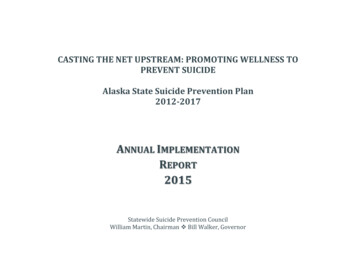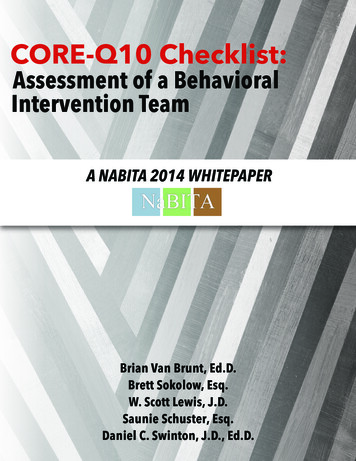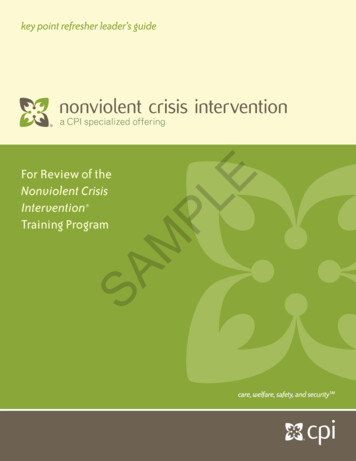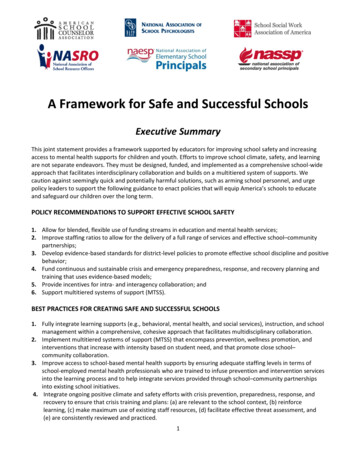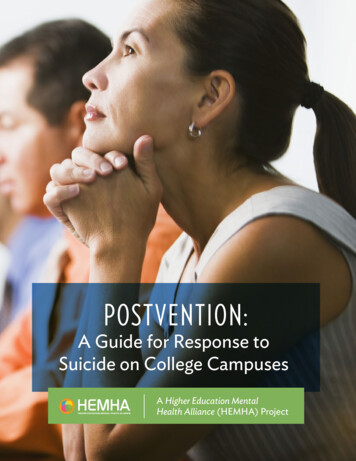
Transcription
POSTVENTION:A Guide for Response toSuicide on College CampusesA Higher Education MentalHealth Alliance (HEMHA) Project1
ACKNOWLEDGMENTSAbout the Higher Education Mental Health Alliance (HEMHA)Envisioned and formed in September 2008 under the leadership of the American College Health Association(ACHA), the Higher Education Mental Health Alliance (HEMHA) is a partnership of organizations dedicatedto advancing college mental health. The Alliance affirms that the issue of college mental health is central tostudent success, and therefore, is the responsibility of higher education.The following individuals provided valuable input and oversight on the creation of this guide.The American College Counseling Association (ACCA)Kathryn P. (Tina) Alessandria, PhD, LPCMH, ACSAssociate Professor, Department of Counselor Education,West Chester UniversityMonica Osburn, PhDDirector, Counseling Center, NC State UniversityThe American Psychological Association (APA)/Society of Counseling Psychology (SCP)Traci E. Callandrillo, PhDAssistant Director for Clinical Services, Counseling Center,American UniversityThe American Psychiatric Association (APA)The American College Personnel Association (ACPA)Melissa Bartsch, PhDAssistant Director/Director of Training, University ofTennessee-KnoxvilleEric Klingensmith, PsyDAssistant Director, Grand Valley State UniversityCounseling CenterLeigh White, MDChief, Psychiatry Services, Michigan State UniversityStudent HealthThe Association for University and College CounselingCenter Directors (AUCCCD)Dan Jones, PhD, ABPPDirector, Counseling Center, Appalachian State UniversityThe American College Health Association (ACHA)Chris Brownson, PhDDirector, Counseling and Mental Health Center, Universityof Texas, AustinJohn Kolligian, Jr., PhDExecutive Director, University Health Services, PrincetonUniversityNASPA - Student Affairs Administrators inHigher EducationStephanie A. Gordon, EdMVice President for Professional DevelopmentThe Jed FoundationThe American Psychological Association (APA)Shari Robinson, PhDAssociate Director for Clinical Services, University of FloridaJennifer Beard SmulsonOfficer, APASenior Legislative and Federal Affairs OfficerJohn MacPhee, MBA, MPHExecutive DirectorJillian NiesleyProgram DirectorVictor Schwartz, MDMedical DirectorJenna Scott, PsyDPostdoctoral Research Fellow2
SUPPORTThis resource was made possible by additional generous support from these HEMHA member organizations:The American College Counseling Association (ACCA)The American College Counseling Association, a division of the American Counseling Association, is madeup of diverse mental health professionals from the fields of counseling, psychology, and social work whosecommon theme is working within higher education settings.The American College Health Association (ACHA)Since 1920, The American College Health Association has linked college health professionals in order toprovide advocacy, education, communications, products, and services, as well as promote research andculturally competent practices to enhance its members’ ability to advance the health of all students andthe campus community.The American Psychiatric Association (APA)The American Psychiatric Association, founded in 1844, is the world’s largest psychiatric organization. Itsmember physicians work together to ensure humane care and effective treatment for all persons with mentaldisorders, including intellectual disabilities and substance use disorders. APA is the voice and conscience ofmodern psychiatry.The Association for University and College Counseling Center Directors (AUCCCD)The Association for University and College Counseling Center Directors works to assist college/universitydirectors in providing effective leadership and management of their centers, in accord with the professionalprinciples and standards with special attention to issues of diversity and multiculturalism.The Jed FoundationThe Jed Foundation is the nation’s leading non-profit organization working to promote emotional health andprevent suicide among college and university students.NASPA - Student Affairs Administrators in Higher EducationNASPA is the leading association for the advancement, health, and sustainability of the student affairsprofession, serving a full range of professionals who provide programs, experiences, and services thatcultivate student learning and success in concert with the mission of our colleges and universities.3
PROJECT ADVISORSHEMHA is grateful to the following individuals who provided resources, reviewed materials, and generouslytook the time to share their insights and experience.Moisés Barón, PhDAssistant Vice President forStudent Affairs, WellnessUniversity of San DiegoChris Brownson, PhDDirector, Counseling and MentalHealth Center, University of Texas,AustinM. Dolores Cimini, PhDAssistant Director for Preventionand Program EvaluationUniversity Counseling CenterUniversity at AlbanyEugene R. Deisinger, PhDDeputy Chief & Director ofThreat ManagementVirginia TechManaging DirectorSIGMA Threat ManagementAssociatesGreg Eells, PhDAssociate Director of GannettHealth Services,Director of Counseling andPsychological Services (CAPS)Cornell UniversityDan Jones, PhD, ABPPDirector, Counseling Center,Appalachian State UniversityPhil Meilman, PhDDirectorGeorgetown UniversityCounseling CenterBrian Mistler, PhDAssociate Dean of StudentsHealth Services DirectorRingling College of Art and DesignMonica Osburn, PhDDirector, Counseling CenterNC State UniversityEric Owens, PhDAssistant Professor, CounselorEducationWest Chester UniversityKerri Smith, LCSW, MPHSenior Campus Prevention SpecialistSuicide Prevention Resource CenterSteve Sprinkle, PhDDirectorUniversity of San DiegoCounseling CenterCory Wallack, PhDDirectorSyracuse University CounselingCenterJane Wiggins, PhDDirector, Campus SuicidePrevention Center of VirginiaJames Madison UniversityThis resource guide has drawn heavily on the writings of Dolores Cimini, PhD, Phil Meilman, PhD, Cory Wallack,PhD and their colleagues. Particularly:Dolores Cimini & Estela Rivero’s – Postsuicide Intervention as a Prevention Tool: Developing a ComprehensiveCampus Response to Suicide and Related Risk in Preventing College Student Suicide, 2013Phil Meilman & Tanni Hall’s – Aftermath of tragic events: The development and use of community supportmeetings on a University Campus in Journal of American College Health, 2006We would like to thank Jenna Scott, PsyD, Postdoctoral Research Fellow at The Jed Foundation, for her majorrole in preparing this document.4
INTRODUCTIONThis resource is intended for use by colleges anduniversities that are affected by and/or wantto be prepared for campus crises and campusdeaths. Suicide postvention efforts address theneed for predetermined strategies to effectivelyand sensitively respond to campus deaths afterthey occur. We believe that it is important to notethat a good postvention plan can have a positiveimpact on prevention, as well. This resource definesspecific areas of consideration and planning andoffers suggestions for best practices. Planning andimplementation of postvention efforts rely heavily onusing an interdisciplinary approach that utilizes theskills and resources of administrators, practitionersand the greater campus community. These disciplineswill ideally collaborate in the postvention planningand coordination, implementation of postventionefforts, clinical services, communication efforts, anddecisions about holding memorials and other relatedevents with the goal of helping the community returnto a normal routine.It is our hope in developing this guide that schools willbe better prepared to manage the painful challengeof a student suicide death. While our hope is thatschools will use this guide to help with planning sothat systems are in place to respond, we have triedto make this guide sufficiently concise to be valuablealso when a school has not engaged in planning butis faced with a student suicide and needs to rapidlydevelop and implement a response plan. We havetried to develop guidance that is adaptable to the fullrange of institutions of higher education. 5
DEFINING POSTVENTIONSuicide postvention involves a series of plannedinterventions with those affected by a campus suicidewith the intention to: Facilitate the grieving or adjustment process,Stabilize the environment,Reduce the risk of negative behaviors,Limit the risk of further suicides through contagionCollege and university postvention is the provision ofpsychological support, crisis intervention and otherforms of assistance to those affected by a campussuicide. The structure of the suicide postventionprogram should fit with the specific needs of thecampus community. GOALS OF POSTVENTIONIn the aftermath of a suicide on campus, postventionefforts are directed towards helping the campuscommunity get back to their pre-crisis level offunctioning and even to develop new skills for dealingwith challenges in the future. Postvention effortsshould effectively: help those impacted by suicide deal with thecurrent trauma and grief and reduce the intensityof an individual’s or group’s emotional, mental,physical and behavioral reactions to a crisis stabilize the campus community, restore somesemblance of order and routine, and help thecommunity return to their pre-crisis level offunctioning prevent (or at least limit the risk of) furthersuicides and imitative suicidal behavior throughcontagion, as other students in the communitywho are struggling with psychological pain maybe influenced to act in a similar way. After hearingabout a suicide death, those who are already atrisk for suicide may develop a greater sense thatsuicide is a viable option help students, faculty and staff solve problemsas this may help to enhance independentfunctioning facilitate understanding and help the campuscommunity: process what has happened encourage the expression of difficult emotions help individuals understand the impact ofthe event avoid institutionalizing grief (i.e., when thememory of a campus suicide becomes ingrainedin the institution to the point that it becomesdifficult to remember the community as safe orwithout grief) allow for learning from current postventionefforts to improve future prevention, postventionand response efforts PLANNINGPostvention planning should ideally be done inadvance and be specific enough to be useful, whileflexible enough to apply to different circumstances.This pre-crisis planning is important because in theaftermath of a campus suicide, when emotions andtensions are high, it is very difficult to respond withouthaving guidelines or plans in place. Timing is crucial when responding to a campussuicide. The best way to assure that a coordinatedresponse will be rapid is to have it planned outahead of time. A small amount of help given quickly will be more6
effective and efficacious than a large amount ofhelp given later when the individual’s/survivor’s/campus’s receptivity has lessened.Various offices, faculty, and community memberswill be responsible for deploying aspects of thepostvention plan. Postvention planning shouldemphasize the importance of interdisciplinarycommunication and coordination. FORMING A POSTVENTIONCOMMITTEEA key consideration in postvention planning includesthe identification of stakeholders who will act as thepostvention coordinators and also develop interventionguidelines that meet campus needs. This is a wayof establishing a team of people who will deploypostvention plans in the event of a suicide. In additionto the postvention coordinators, other individuals andoffices on campus should be informed of their possibleroles in postvention tasks. Effective interdisciplinarycoordination and communication after a campussuicide can streamline postvention efforts, reduceerrors and provide comprehensive support to thecommunity. Campuses should identify individuals responsiblefor postvention planning and implementationBEFORE a suicide occurs. The postvention committee members could overlapwith other campus teams or function as a subcommittee of previously established campus teams(e.g. the campus Behavioral Intervention Team– BIT or crisis management committee could havea sub-committee to address postvention). Keepin mind that, in addition to the campus BehavioralIntervention Team, postvention stakeholders may alsoinclude staff from the communications department,legal department and campus chaplaincy. A Chair (or lead coordinator) should be appointedto the committee and a “point person(s)” shouldbe identified to respond to all questions aboutthe protocol. The committee chair and the pointperson may be the same individual. Examples offaculty/staff who might fill these positions include:the Dean or VP of Student Affairs, the counselingcenter director, or a public safety leader. Campusfaculty and/or staff who hold these positions shoulddo their best to educate themselves about suicidepostvention. The Committee Chair should have experiencemanaging student deaths or suicide responseprocesses, have influence and be a trusted figure inthe campus community.EXAMPLE:The College of Holy Cross identifies an individual asthe Postvention Coordinator (PVC). The PVC hasgeneral responsibility for the overall management of thecampus’s response to a catastrophic emergency. Thisindividual determines if a given event is to be classifiedas “catastrophic,” and if it is, calls meetings, assignsresponsibilities and monitors, conducts and managesthe organization of the tasks (see The College of HolyCross Postvention Manual).Other relevant offices and individuals that may haveroles in suicide postvention include: student affairs leadership – for involvement indisseminating information to campus community andcommunicating with the family of the deceased counseling and psychological services andleadership – discussed in greater detail in thefollowing pages7
When there is no campus counseling center, amental health consultant must be enlisted toensure that all elements of the response processaddress the many complex mental health issuesthat may arise after a student death or crisis. Ifan outside mental health consultant is enlistedin this case, they should also be a part of theplanning, training and tabletop exercises sothat they are aware of the systems in place. health center – may be involved with making thefirst contact with the family of the deceased disability office – may have important informationabout students who are at risk and be an importantresource for connecting these students with othersupport services campus security/police – may coordinate withlocal law enforcement and medical examiner andmanage unsafe areas on campus financial aid/registrar or enrollmentmanagement – to coordinate and appropriatelycommunicate with family after student death (e.g.make deceased student’s and surviving family’s e-mailaddress inactive to prevent further communicationregarding enrollment and/or tuition payment) campus media relations/public relations office– to aid with internal and external communicationsflow, discussed in greater detail in the following pages residence hall leadership - to assist with anythingrelated to the deceased student’s residence, theirpersonal effects, and connecting with students inresidence halls legal affairs/risk management office – maybe a consultative resource for other postventionstakeholders chaplaincy – because of the likelihood that they willmeet with students in the campus community whoare grieving and for their contribution to coordinatingappropriate messaging to the community Fraternity and Sorority Life - because of thesource of connection to students international student office – to collaborateafter the death of an international student and alsoto develop protocols for a student suicide which mayoccur while a student is studying abroad campus office of environmental safety/localdepartment of health – should be included indecisions around safe handling of remains and cleanup after a suicide information technology (IT) department –to assist with ease of communication needs (e.g.enabling computer, internet and/or intranet access tostaff who need to work remotely on campus in orderto be more accessible to affected students)The postvention leaders/implementers and on-theground responders will have significant overlap but arenot necessarily identical individuals. A postventionleader is likely organizing implementation effortsin each area of the postvention protocol but willalso enlist clinical and functional staff members tocarry out implementation and dissemination. Forexample, the director of counseling services willlikely be a member of the postvention committee butcounseling service staff will be involved in on-theground postvention interventions.Each office may have an identified postventionliaison and should consider educating several otherstakeholders in their department about postventionprotocol responsibilities (including what informationcan and cannot be released to the community) in theevent that the liaison is unavailable at the time of a crisis.8
The planning phase may include table-top exercisesand defining specific postvention terminologyto prepare and practice for fluid communicationand coordination between those with postventionresponsibilities. Tabletop exercises should includeimmediate responses to crises and continuedrecovery and postvention efforts for the followingseveral weeks. This provides an opportunity forcommittee members to walk through their roles inthe event of a suicide and in the weeks that follow asuicide. It is also important to keep in mind that reallife events are often far more complex than tabletop practice exercises and that crises/tragedies aredynamic – they unfold over time. Other campus services (e.g., throughacademic departments such as social work,psychology, nursing, Health Promotion,medical school or counselor education)? Howmight they be coordinated as part of a unifiedresponse to the campus community? Community resources (e.g., communitymental health agencies, crisis responseteams, and other local campuses with similarpostvention teams)? Religious/spiritual resources? With whom do you have off-campus partnerships? With whom do you need to develop offcampus partnerships?COORDINATION local law enforcementIt is essential for postvention coordinators andteam members to have a clear identification andunderstanding of the duties assigned to theirpostvention counterparts internally in variousdepartments and externally, off-campus in the localcommunity. It is also important for the connectionsto off-campus resources/partners to have beenconsidered and to the extent possible, have preexisting relationships with these offices and agencies(e.g., health and mental health resources, local lawenforcement, local news and media). As much aspossible, there should be an identified contact for theoff-campus offices/agencies hospital/emergency roomQUESTIONS TO CONSIDER WHILEDEVELOPING A POSTVENTION PROTOCOLIn the beginning phases of postvention planning itis important to ask questions about your campus’sunique needs and resources. For example: fire department psychiatric center/mental health clinics/medical examiner What postvention protocols are you currentlyusing? For example: Do you have a media communication strategythat you use in the event of a suicide on campus? Do you have a protocol for identifying at-riskstudents after a campus suicide? Are there any system-wide issues that may affectefficient implementation of the protocol? What are some practical considerations toaddress? For example, who packs up a deceasedstudent’s room? Check-in with your staff about how the campus’scurrent response to student death/suicide isworking through a review process. Where werethe gaps? What were the challenges? Learn fromyour mistakes. How do you hear about and track campus suicides? What support resources do you have? In counseling services?9
POSTVENTION PROTOCOLS SHOULD: quickly mobilize and organize resources provide both immediate (i.e., within 72 hours of event) and long-term plans (e.g., anniversaries) set up communication channels on campus and with relevant off campus offices and agencies secure campus safety establish clear procedures include a broad base of campus representatives and delegate responsibilities be specific enough to be useful be flexible enough to apply to different circumstances be sustainable (tied to positions rather than specific individuals) be free of bias, consider the ethnic, racial, cultural and spiritual, sexual orientation/identity andother diversity aspects of your student body address the complex mental health issues for individuals and groups that may arise after a student suicide avoid jargon and be understandable to the diverse group of professionals who areinvolved in postventionIMPLEMENTATIONOnce key postvention stakeholders are established,and the specific needs of the campus have beendetermined, these individuals should outline anddocument postvention procedures and protocols thatclearly describe how the campus will provide supportand assistance to students after a campus suicide.The campus postvention leaders should address thefollowing in postvention protocols: How will information about a campus suicide becommunicated to the campus community? Thisshould include campus media and social media. What clinical services are available and appropriate following a campus suicide? How will the campus handle memorials andrelated events?The postvention committee should meet briefly atscheduled intervals during postvention deploymentto assess implementation and effectiveness of efforts.During the implementation phase, it may be helpfulfor postvention committee members to keep notesor a diary on actions taken (keeping notes duringpostvention deployment should also be discussedwith the university’s legal counsel). This can behelpful in reviewing specific postvention efforts10
afterwards. Throughout the implementation phase,postvention efforts should also highlight self-care ofresponders as postvention and interventions unfold.More information about self-care and support forresponders and those directly involved with thedeceased student are discussed below in the sectionon Self-care for responders and When the studentwho died by suicide was a counseling center client. Alcohol and Drug Related DeathsWhen a student dies of an alcohol, prescriptionor illicit drug overdose it may be unknownwhether the death was intentional or accidental.In this circumstance it is advisable to implementsuicide postvention plans.COMMUNICATIONSPostvention protocols should address how to bestcommunicate information to the campus andcommunity after a suicide. It is important that thedeath be addressed openly and directly. After asuicide, once the basic facts are known, any attemptto delay informing students will only encourage rumors.How this information is conveyed is very important.If communication efforts are not carried out in aneffective manner the rest of the postvention executionwill suffer and community anxiety will increase.Because of today’s immediate communication cultureand the speed at which information spreads via socialmedia, the postvention committee needs to be readyto communicate quickly to affected students and thecampus community. Further, postvention leaders mayalso encourage surviving roommates and friends tolimit their social media communication until officialdeath notifications are made to the surviving family andcommunity (more on the effects of social media below).At the same time, efforts need to be made toensure accuracy of information reported. Criticalto communicating about suicide, in general, is theuse of safe messaging and understanding how communicating about suicide can influence contagion.Although no single approach to communicationsis adequate for every school and community, we dobelieve in following certain messaging considerationsin supporting schools through the tragedy as wellas reducing the risk of contagion for those at riskfor suicidal behavior. The communication processneeds to be dynamic and nimble. There is no exactprotocol or process for carrying out postventioncommunications. The process will depend on howinformation unfolds over time. The committee mustbe prepared for change as information changes.Crisis communication in postvention addresses bothinformation that comes into the school system andalso the dissemination of information that goes fromthe school system to the community/public.GENERAL COMMUNICATIONCONSIDERATIONS The committee needs to decide on levels andplatforms for communication with students,campus faculty and staff, and outside media.Determine who will write and who will signnotes to the community: University president?VP of student affairs? How are these notesdisseminated? It is important to consider howthese communications would change dependingon time of year (e.g. if a student died during thesummer) or if the deceased student was not wellconnected to the campus community, etc. (SeeSample Announcement, Figure 1). The type of information shared will depend on thesetting, what is known and what the desires areof the survivors (See Communicating with thefamily of the deceased).11
Effective communication requires carefulcoordination between media office, studentaffairs, and counseling leadership and review ofsafe messaging about suicide (See Figure 2 forRecommendations for Reporting on Suicide). When communicating about suicide, communityanxiety may increase if information is too vagueor limited. Risk for copycats is enhanced whendetails (such as method of suicide) are highlightedor suicide is “dramatized/romanticized” (Refer tothe National Action Alliance for Suicide PreventionFramework for Successful Messaging). Communication should also balance students’desire for information about funeral arrangementswith parents’ wishes around privacy (e.g., familymay want a small, intimate funeral service). Whenthe family wishes to keep funeral arrangementsprivate, students who want to remember thedeceased can do so in other ways – more information on this is provided under Memorials andRelated Events. The campus media office, the counseling director andthe legal affairs office should educate the postventioncommittee about safety and privacy concerns.The most efficient strategy for providing details of thedeath is a written statement that can be distributedto everyone in the campus community, usually viacampus-wide e-mail. All electronic messages tothe community should be written and shared withthe assumption that the media may access anduse the information. The postvention coordinatorsshould determine the most appropriate mode ofcommunication. At a large university, communicationabout a student death may be to a school within theuniversity that the student was a part of. For example,if a student at the university dental school, which islocated on a separate campus from the main universitycampus, dies by suicide, the decision could be tocommunicate only to students on that campus or onlyto dental students. The postvention coordinators mayalso provide different levels of information to differentsub-groups within the community. Statements shouldgenerally include: condolences to family and friends plans to provide support to those impacted any changes in school or work schedule during theupcoming daysStatements about a student suicide that aredisseminated to the campus community shouldonly offer confirmation of a suicide in specificcircumstances:1. if the family approves and2. the postvention coordinators decide that it wouldbe disingenuous to leave out this information(particularly if it was very public or if factualinformation about the suicide is already known inthe community)Below is a sample campus communication acknowledging the student death. Wording optionsare presented for instances when the postventioncoordinators agree that acknowledging the suicide isan appropriate course of action. Alternative wordingsare presented in the event it is decided it is NOTappropriate to acknowledge the death was a suicide:Figure 1Sample AnnouncementAS NOTED ABOVE: The release of a student name orcause of death in an announcement, as illustratedin the example on the next page, should only bemade when such information has become public.12
Dear Members of the [university name]Community:I am deeply saddened to inform you of thetragic loss of a member of our [university name]family. [Name of student] [took his/her life/passed away] on [date]. We offer our deepestcondolences to [student name]’s family, friendsand loved ones.During this time of great loss, we are remindedof the importance of community. Losing afellow student and member of our Universitycan be very difficult. I encourage those who feelthey may need additional support to contactthe Counseling Center (phone number), theInterfaith Center (phone number), [insertadditional names and contact information forcampus and community support services andlocal and national hotlines] as well as [academicdean’s office] (phone number) for any emotionalor academic assistance you may need.Sincerely,PresidentCOMMUNICATING WITH FRIENDSOF THE DECEASEDThere may be several layers of simultaneouscommunication to consider. After a campus death theentire campus community may receive a letter aboutthe incident via e-mail. At the same time, the deanof students, another appropriate administrator, and/or clinician can connect with students more closelylinked to the deceased in a face-to-face meetingto provide them with more specific and detailedinformation (e.g. information about funeral services).This face-to-face meeting also provides an opportunityfor the postvention committee to check in with thoseclose to the deceased, notice uncommon responses
Since 1920, The American College Health Association has linked college health professionals in order to provide advocacy, education, communications, products, and services, as well as promote research and culturally competent practices to enhance its members' ability to advance the health of all students and the campus community.
